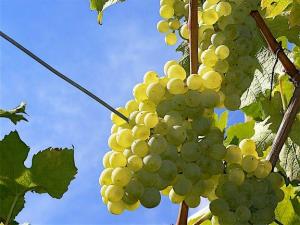
In my never ending series of grapes for the Puget Sound, next up is a grape called Madeleine Angevine.
Madeleine Angevine (MA) has been grown in the Puget Sound for close to 30 years. Bainbridge Island Vineyards has been growing it for most of that time and makes a really good wine out of it. MA has a bit of a checkered past. It supposedly came from the Loire valley in France originally and is thought to be an eating grape before there were hybrids like we have today from the USA that need minimal spraying and have the ability to last forever in the fridge.
Let’s back up a little and talk about the history of MA. Like I mentioned above, MA supposedly comes from the Loire Valley area and is still sold an eating grape in the Loire valley. As with many eating grapes in Europe, they are also 100% Vitis Vinifera just as wine grapes, therefore they can for the most part make decent wine. It has been speculated that MA is used in crummy years in the Loire to bolster thin wines because it does ripen so early, but there is no evidence of this happening.
Way back in the mists of time, a breeder named Moreau-Robert in the Loire valley bred MA by crossing Précoce de Malingre and Madeleine Royale in 1857. Then a guy named Barrington Brock in England somewhere around 60-70 years ago mixed up some vines in his nursery and another grape took on the name Madeleine Angevine. This vine is widely planted in England where it has quite a bit of success, but is completely different and is most likely a French/American hybrid grape. One big difference between he original MA and the one in England is that the English one has a strong muscat aroma. The vines we have in the USA are most likely the original French variety since the wines we make from MA are fairly neutral without any muscat aromas.
So here we are in the USA, it’s thought that MA came to the Pacific Northwest through Canada in the late 1970s. That’s when Gerard Bentryn started to plant it at Bainbridge Island Vineyards and it has spread throughout the Puget Sound basin.
IMHO, it makes a decent wine, but not great wine. Easy drinking and light. Not very complex. The best examples come from the cooler regions of the Puget Sound. If I were to grow it in Woodinville it might actually ripen too early most years to have any real complexity. Lopez Island Vineyards, San Juan Island Vineyards and Whidbey Island Vineyards all make great examples probably because it ripens so late for them. Like Siegerrebe it loses acids quickly when it hits around 20 brix. It also has thin skins so it is quite susceptible to powdery mildew. Clusters are fairly loose so botrytis isn’t usually a problem mainly because it ripens before the rains come here in the PNW. One of the chief benefits of the grape is that it does give a huge crop of grapes and you can grow 4+ tons an acre from it.
Again, would I plant it in Woodinville? Same as I mentioned in the Siegerrebe blog entry, if I had large acreage and wanted some insurance that I would get a crop every year, I would plant it. For backyard growers, I have to recommend it with reservations. It is pretty disease prone so you must maintain a good spray schedule. But if you are in a very marginal situation such as being on one of the islands, it may be one of the few grapes you can grow. I’m on the hunt for a highly disease resistant white grape for our climate and I thought Phoenix might be it, but in the first year that I had fruit, they all split in a down pour. Not one other grape did that!
